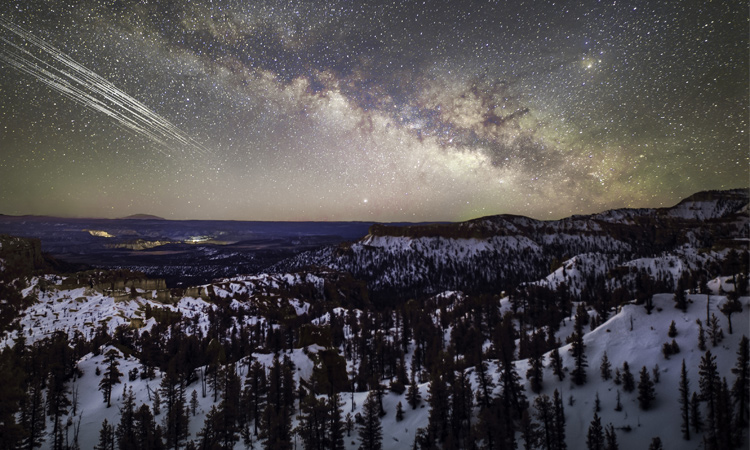 A stack of multiple consecutive exposures, across a 30 minute timespan, captured the trails of Starlink satellites over Bryce Canyon, Utah, USA. [Spencer’s Camera and Photo]
A stack of multiple consecutive exposures, across a 30 minute timespan, captured the trails of Starlink satellites over Bryce Canyon, Utah, USA. [Spencer’s Camera and Photo]
SpaceX—the space-technology company founded in 2002 by entrepreneur Elon Musk—had made no secret of its plans. The firm began talking in 2015 about putting a constellation of thousands of communication satellites into low-earth orbit (LEO), and launched the first two of its “Starlink” satellites on 22 February 2018. Yet the first mass launch of 60 Starlink satellites on 23 May 2019 caught astronomers flat-footed, as astronomical photos revealed streaks from the satellites, covering the sky with light pollution.
A new generation of telescopes promises dramatic advances in studies of the deep universe. To achieve their mission, however, these observatories depend on clear, dark skies.
“Until we saw ... 60 of them clumped together in the sky, we had no idea how bright they were and no idea of their impact,” says Constance Walker, a scientist at the NOIRLab of the U.S. National Science Foundation (NSF) in Tucson, Arizona.
The astronomy community—stunned, and embarrassed not to have seen what was coming—immediately contacted SpaceX, and Walker says the company responded graciously. Since then, astronomers and SpaceX engineers have worked together to understand why the satellites reflect so much light, how they might affect astronomy and what might be done to reduce that impact. In the nearly two years since the rude shock of the Starlink mass launch, meanwhile, the astronomy community has assembled two separate workshops stressing the need for urgent action to address the problem—one that, if left unsolved, could spell big trouble for next-generation, Earth-based telescopes seeking new insights from deep-space surveys.
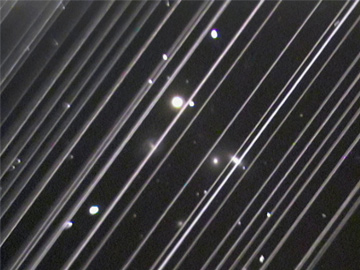 Astronomical image from Lowell Observatory, AZ, USA, showing trails of light from 25 SpaceX Starlink satellites passing the telescope’s field of view, a few days after launch. The satellites tend to become dimmer when they reach final orbit. [Victoria Girgis/Lowell Observatory]
Astronomical image from Lowell Observatory, AZ, USA, showing trails of light from 25 SpaceX Starlink satellites passing the telescope’s field of view, a few days after launch. The satellites tend to become dimmer when they reach final orbit. [Victoria Girgis/Lowell Observatory]
An industrial boom in space
While SpaceX has led in commercializing space and in satellite constellations, it has plenty of company. A few weeks before the 2019 launch, Aviation Week & Space Technology reported that 32 firms had plans to launch a total of 13,529 communication satellites into LEO. By the time of the astronomy community’s workshops last year, the total number of proposed LEO communication satellites, by some estimates, had mushroomed to around 100,000.
In 2018, the U.S. Federal Communications Commission (FCC) approved deployment of a fleet of 4,425 Starlink satellites, in orbits ranging from 550 to 1325 km; later, it increased the approved number to 12,000, in orbits as low as 340 km. (SpaceX has announced plans for another 30,000 Starlinks.) The agency’s main interest lies in improving broadband internet service in underserved U.S. areas. But the Starlink service will be global. Laser links will transport signals between satellites, with radio transmitters connecting the satellites with ground terminals.
A British company, OneWeb, is also building a constellation chasing the same market. Only 74 of its originally planned fleet of 47,844 satellites had been launched when the firm entered bankruptcy in March 2020. Astronomers hoped the scheme was dead, but the British government later took part-ownership, bailed OneWeb out of bankruptcy in November 2020, and paid to launch 36 more satellites in December. In January 2021 OneWeb obtained outside funding to complete a much-shrunken constellation of 648 satellites; current plans are to later expand the constellation to 6,372.
Another familiar name, Amazon, has plans for its Project Kuiper to loft 3,236 satellites into LEO, but has so far launched none and released no timetable. Startups such as AST SpaceMobile and Swarm plan smaller constellations of more than a hundred satellites aimed at niche markets such as mobile communications and the Internet of Things. Companies in China also reportedly have their own plans, filed with the International Telecommunications Union, for 12,992 satellites; still other plans are evolving, with total numbers hard to pin down.
A new kind of light pollution
Space technology has given astronomers a vital observing post above Earth’s blurry atmosphere, most notably in the Hubble Space Telescope and in next-gen projects such as the expensive, complex James Webb Space Telescope. Ground-based telescopes are cheaper, larger and can be remarkably sharp with adaptive optics. A new generation of such telescopes coming online in the next decade promises dramatic advances in studies of the deep universe (see “A Deeper View of the Cosmos,” OPN, September 2020, p. 42).
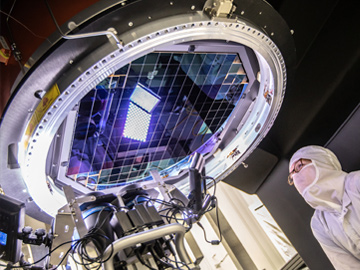 The large CCD array at the heart of the Vera C. Rubin Observatory’s ultrasensitive camera. [J.Orrell/SLAC National Accelerator Laboratory]
The large CCD array at the heart of the Vera C. Rubin Observatory’s ultrasensitive camera. [J.Orrell/SLAC National Accelerator Laboratory]
To achieve their mission, however, those new observatories depend on clear, dark skies. In the past, large observatories dodged light pollution by locating in remote, dark areas such as the Atacama Desert in Chile, or on Mauna Kea in Hawaii. Now, for the first time, light pollution from spacecraft threatens Earth-based astronomy’s view of the sky—and a remote location offers no escape.
Under particular threat is the 8.4-m Vera C. Rubin Observatory, high in the Chilean mountains. With a 3200-megapixel imaging camera, the Rubin telescope has the largest etendue—the product of its effective light-collecting area and its angular field—of any camera in the world. Built to sweep the whole sky visible from Chile repeatedly for the 10-year Legacy Survey of Space and Time (LSST), the camera will focus, every 30 seconds, on 9.6 square degrees of sky, recording objects down to an incredibly faint magnitude 24.5. (In astronomy, the lower the magnitude number, the brighter the object. The faintest stars visible to the unaided eye on a very dark night are magnitude 7; the sun has a negative magnitude, –26.74.)
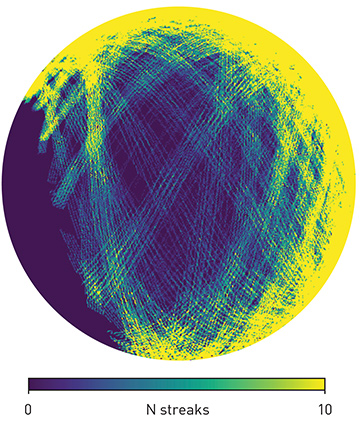 A simulation by Peter Yoachim, University of Washington, USA, showing the tracks of 47,708 illuminated LEO satellites from the point of view of the Vera C. Rubin Observatory in Chile over a 10-minute period shortly after twilight, gives some suggestion of the difficulty of scheduling observations around the impact of the satellite tracks. [Courtesy of P. Yoachim, in SATCON1 report]
A simulation by Peter Yoachim, University of Washington, USA, showing the tracks of 47,708 illuminated LEO satellites from the point of view of the Vera C. Rubin Observatory in Chile over a 10-minute period shortly after twilight, gives some suggestion of the difficulty of scheduling observations around the impact of the satellite tracks. [Courtesy of P. Yoachim, in SATCON1 report]
The LSST will yield vast amounts of data for scientific analysis—making it especially vulnerable to systematic errors likely to arise from trails of satellites following regular orbits across the sky, according to Tony Tyson, chief scientist of the Rubin observatory. Also, the camera’s use of extremely-low-noise charge-coupled device (CCD) detectors to observe ultra-faint sources makes it vulnerable to an effect called “blooming”: If bright light saturates a pixel, it can wipe out the data recorded in a whole column of sensors.
Even if satellite brightness can be reduced, the sensitive camera will record trails that will have to be masked out to keep from obscuring the images. That, Tyson has warned, will add to the observing time needed, and the three-arcsecond-wide images of satellites in 550-km orbits would inevitably wipe out data for such sensitive telescopes. In addition to hobbling observations of the deep sky, this could affect another major mission of the Rubin Observatory—searching for potentially threatening near-Earth asteroids and comets.
Wrestling with scattered sunlight
In mid-2019, when astronomers first awoke to the threat from the SpaceX constellations, it was obvious the satellites reflected sunlight down toward Earth, but the details were unclear. An early bit of good news was that the scattered sunlight faded somewhat as the satellites moved from their initial 380-km parking orbit to their final 550-km elevation. The reduction, SpaceX explained, came from adjustment of the solar cells to track the sun more efficiently in the final orbit. However, that only reduced the averaged measured visual magnitude to 4.63, leaving the satellites visible to the unaided eye except in areas with serious light pollution.
In mid-2019, when astronomers first awoke to the threat from the SpaceX constellations, it was obvious the satellites reflected sunlight down toward Earth, but the details were unclear.
SpaceX next tried darkening the diffuse white material that had been applied to the satellite radio antennas to keep them cool in orbit. These “DarkSats” went up on the next available mass Starlink launch, and showed solar scattering some 55 percent below standard Starlinks—a decrease of about 0.77 magnitude—which was not as much as hoped. And darkening the satellite surface also caused undesired heating and increased reflectivity in the infrared, a potential problem for NIR observations.
The Starlinks’ unusual shape offered other possible ways to reduce reflections. The satellites consist of two largely flat components that can bend along their junction: a “chassis” including the antennas, transmitters and circuitry, and a flat metal frame containing solar cells. One trick the design made possible was reducing the reflected light within a week after launch by changing the attitude at which the satellites fly on their way to their operational orbit, so that the thin edge of the solar panel faces the sun and only a very narrow area can reflect sunlight to the ground.
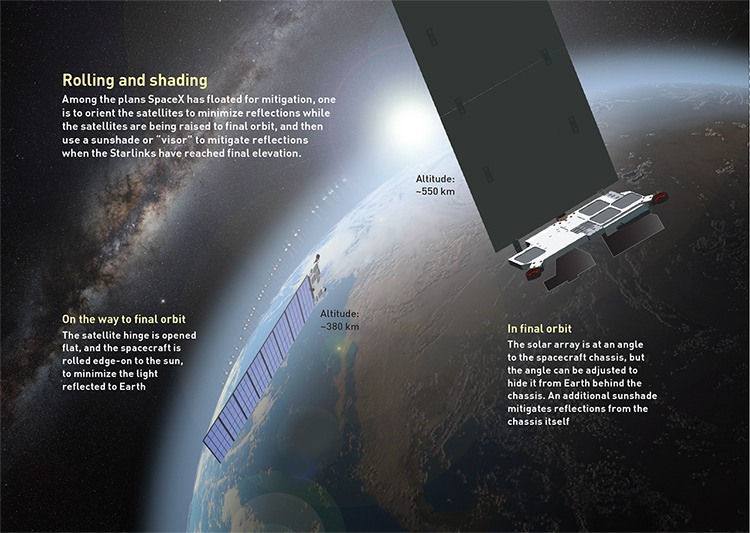 [Illustration by Phil Saunders/Background: ESO] [Enlarge graphic]
[Illustration by Phil Saunders/Background: ESO] [Enlarge graphic]
Once in operational orbit, with the solar panels turned to face the sun and collect energy, the bright reflections, according to SpaceX modeling, come when the sun illuminates the underside of the satellite. This geometry happens only in twilight, when the sun is below the horizon but the satellite is not yet in Earth’s shadow, so sunlight strikes the bottom of the satellite at a low angle and can be reflected down to the ground.
Thanks to this odd geometry, the brightness of the reflected light does not vary with phase angle as for other satellites. The unusual geometry also opened the possibility for SpaceX to add a light-blocking rim or “visor” around the edge of the satellite. The visor could be turned down to block sunlight from reaching the antennas that might otherwise reflect sunlight, and also avoid the heating caused when the dark surface absorbed light. (The visor is opaque optically, but not to radio frequencies, which must reach the antennas.)
The first “VisorSat” was launched on 4 June 2020 in the seventh batch of Starlinks. From 430 observations after the satellite has reached 550-km orbit, Anthony Mallama, a retired astronomer in Maryland, USA, found that VisorSat had a visual magnitude of 5.92—1.29 magnitudes fainter than the magnitude 4.63 of the original Starlink design. That meant VisorSat reflected only 31% as much light as the original design, which Mallama calls a “marked improvement” (though it’s still plainly visible in a dark sky). SpaceX has used the VisorSat design for all Starlinks since the ninth mass launch on 7 August 2020, and says its goal is magnitude 7 or fainter for most phases of satellite operation.
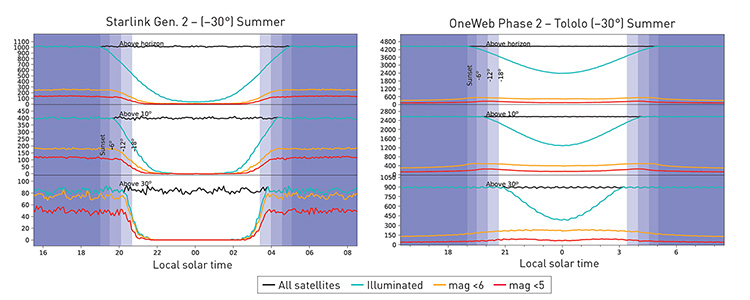 Calculations comparing visibility (during summer, at the location of the Vera Rubin Observatory) of proposed Starlink Generation 2 satellites, most at around 350-km altitude, and phase two of the plans of OneWeb, which would place tens of thousands of satellites at a higher altitude of 1200 km. While the higher-altitude OneWeb satellites would be dimmer, they would be illuminated and visible during the entire night, whereas the Starlink craft would cease to be illuminated shortly after twilight. [O. Hainaut, ESO, in SATCON1 report] [Enlarge graphic]
Calculations comparing visibility (during summer, at the location of the Vera Rubin Observatory) of proposed Starlink Generation 2 satellites, most at around 350-km altitude, and phase two of the plans of OneWeb, which would place tens of thousands of satellites at a higher altitude of 1200 km. While the higher-altitude OneWeb satellites would be dimmer, they would be illuminated and visible during the entire night, whereas the Starlink craft would cease to be illuminated shortly after twilight. [O. Hainaut, ESO, in SATCON1 report] [Enlarge graphic]
Questions of orbit
Notwithstanding these efforts, by mid-2020, astronomers were seeing more and more images of the night sky contaminated by satellite trails. Scientists who just 14 months earlier had looked forward to a new age of exploring the dark sky now feared a juggernaut of light that would blind their latest and greatest telescopes.
Reducing satellite impacts
The SATCON1 workshop identified six approaches to mitigate the threat of satellite megafleets to optical and infrared astronomy.
1. Launch fewer or no LEO satellite constellations. Would require turning off/deorbiting existing satellites to achieve zero impact
2. Orbit satellites at altitudes no higher than 600 km. Would require deactivating/deorbiting satellites in higher orbits
3. Darken satellites by lowering their albedo or shielding them from sunlight. Requires action by companies; SpaceX is doing this with VisorSat
4. Control each satellite’s attitude to minimize reflection of sunlight to the ground. Requires action by satellite operators
5. Computationally remove or mask satellite trails from being recorded on images. Requires action by observatories
6. Schedule telescope observations to avoid recording trails. Requires coordination between observatories and satellite operators
To assess the constellations’ potential impact, and how to lessen it, astronomers gathered at two virtual workshops. One, SATCON1, was convened by the American Astronomical Society (AAS) and NSF from 29 June to 2 July. The other formed part of the “Dark and Quiet Skies for Science and Society” meeting conducted by the International Astronomical Union from 5 to 9 October. SATCON1 identified six potential approaches for mitigating the threat—ranging from the quixotic (not launching any of the satellites at all) to the numerical (computer processing to remove satellite trails).
In particular, both workshops recommended avoiding orbits above 600 km. OneWeb already has satellites at 1200 km, and some other companies have planned similar orbits. Spacecraft at these altitudes reflect less light to the ground, and telescopes focus that light to smaller spots, than at lower altitudes. But satellites at 1200 km would reflect sunlight to Earth all night long, unlike those below 600 km, which stay in the Earth’s shadow for several hours in the middle of the night.
This has different implications for different programs. As of February 2021, SpaceX had more than a thousand Starlink satellites in orbit near 550 km. It had obtained FCC approval to orbit more than 2,800 Starlinks in four shells ranging from 1100 to 1325 km, but after talking with astronomers it asked the agency to let them orbit at 550 km instead. (So far, the FCC has not acted.) Amazon, which has not yet launched satellites under its Project Kuiper program, says it picked orbits at 590 and 630 km for its planned 3,236-satellite constellation in light of the workshop recommendations.
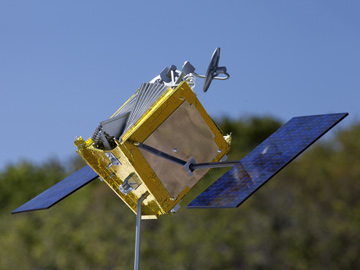 The U.K.-based firm OneWeb has near-term plans for a fleet of 648 satellites, with plans to expand to 6,372 spacecraft in the future. The satellites are boxier in design than those of SpaceX, giving them a different reflectivity profile. [NASA/JPL]
The U.K.-based firm OneWeb has near-term plans for a fleet of 648 satellites, with plans to expand to 6,372 spacecraft in the future. The satellites are boxier in design than those of SpaceX, giving them a different reflectivity profile. [NASA/JPL]
The third big player, OneWeb, has already deployed satellites at 1200 km. Its boxy spacecraft include microwave antennas on short arms and a pair of large solar panels on longer arms, giving them a different reflective profile than Starlinks. Mallama measured the mean brightness of the OneWeb craft already in orbit at magnitude 7.58, with a fairly wide standard deviation of 0.7, probably because of their complex shapes. That’s about 1.6 magnitudes fainter than a VisorSat at 550 km—but, because of the higher orbit, the OneWeb satellites would be visible most of the night.
That makes them much more problematic for astronomers, according to simulations by Jonathan McDowell of the Harvard-Smithsonian Center for Astrophysics, which concluded that constellations at 1200 km would have much more impact on professional astronomy than fleets at lower altitude. Qualitatively, “Starlinks are really annoying but manageable,” he says. “OneWeb is, ‘Pack up your telescope and go home’.”
Maurizo Vanotti, OneWeb’s senior director of technology, told a 14 January 2021 AAS virtual meeting that the company plans to complete its 648-satellite first-generation constellation at 1200 km. Moving existing satellites is impractical, and the design of the remaining spacecraft—many of which have already been built—would need changes for orbits under 600 km. That would be tantamount to starting over. Vanotti did say that OneWeb pursued “responsible space design” but gave no details.
The “space is big” fallacy
The worlds of satellite communications and astronomy have been using the same space, but didn’t realize they might interfere until the first 60 Starlinks lit up the sky in front of astronomers. With most satellites actively emitting radio waves for communications, radio astronomy faces even tougher problems (see “A ‘death ray’ for radio astronomy?,” p. 34).
Satellite communications and astronomy have been using the same space, but didn’t realize they might interfere until the first 60 Starlinks lit up the sky in front of astronomers.
Meanwhile, a vast population of new, privately managed satellites also increases another threat: collisions in space. In 1978, NASA scientist Donald J. Kessler used two decades of military space tracking data to argue that space junk in LEO was accumulating to a point where high-velocity collisions might eventually threaten human activity in space. Subsequently, Kessler warned that continued accumulation of collisional debris could lead to a cascading chain reaction that would shred satellites into shrapnel—the dreaded “Kessler syndrome.”
NASA has tracked space debris since 1979, and routinely issues warnings to move Hubble, the International Space Station and other satellites out of the way of hazardous objects. The only known collision between two satellites took place on 10 February 2009, when an Iridium satellite—part of the first commercial fleet of communication satellites in LEO—smashed into an inoperative Russian Kosmos military communication satellite at a speed of 11.7 km/s at 789 km altitude. The event scattered nearly 2,300 fragments large enough to track from the ground. In September 2019, the European Space Agency had to move its Aeolus wind-measurement satellite out of the way of one of the 60 Starlinks launched a few months earlier.
Collisions and close calls depend on the populations of spacecraft and some 200,000 pieces of orbital debris, only about 20,000 of which are now trackable. Almost all close encounters thus far have involved spacecraft and debris, but that will change as satellite populations increase. A late 2019 simulation by the Center for Space Standards and Innovation found that having 60,000 spacecraft in LEO could increase close encounters between spacecraft to about 40 per year, excluding those involving the much larger population of uncontrollable, largely untrackable space debris.
Unfortunately, projecting future growth of satellite constellations is difficult, as estimates—based on press releases, news reports and regulatory filings—are continually in flux. On the one hand, planned telecom systems often fall through for lack of funding, regulatory approval or demand. On the other, declining launch costs are opening LEO to more ventures, in communications, education and other applications. Whatever the number, once in space, those ventures will share a region increasingly cluttered with satellites and space debris ranging from chips of paint to spent rocket stages.
Because of these imponderables, the anticipated number of LEO satellites has varied over time. In summer 2020, according to astronomer Pat Seitzer of the University of Michigan, the firm Analytical Graphics Inc. projected a total of 107,000 LEO communication satellites by 2029. When OneWeb downsized its planned fleet in bankruptcy proceedings, however, estimates dropped to around 80,000.
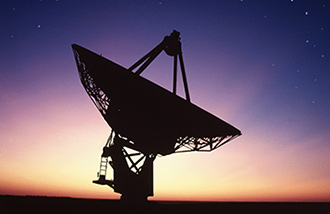 [C. O’Rear/Getty Images]
[C. O’Rear/Getty Images]
A “death ray” for radio astronomy?
Radio astronomy’s problems with satellite constellations differ from those faced by optical astronomy. Satellite-reflected light is noise, so getting rid of it doesn’t jeopardize the satellite’s mission. However, satellites use radio waves to deliver their signals to users, and can’t do their job if their radio output is blocked.
Radio astronomy competes for usable spectrum with other radio applications. During the 20th century, agencies such as the International Telecommunications Union and the U.S. Federal Communications Commission were charged with allocating frequencies to commercial carriers and government agencies as well as to astronomers. Radio astronomers managed to secure protection for important parts of the radio spectrum—when frequencies were readily available.
In recent decades, however, the radio spectrum has become more crowded, and most bands now are shared by multiple users, including satellites. Looking ahead, expansion of radio transmission to higher frequencies and the proliferation of radio transmission in space could put radio astronomy on the endangered list.
The beams of communication satellites in low Earth orbit scan continually across the ground, which is a huge problem if their tracks scan across radio telescopes. That’s because transmitter signals are 60–100 dB stronger than the faint astronomical sources in the sky that the telescopes were built to record. The signals can overload antennas and destroy sensitive receivers, says Harvey Liszt, spectrum manager at the National Radio Astronomy Observatory in Charlottesville, VA, USA. Satellite signals also can spill over into adjacent frequencies, which he says has been a problem for 20 years with the Iridium fleet. The Dark Skies report of the International Astronomical Union specifically recommended avoiding illumination of radio telescopes or quiet zones with satellite beams or side lobes.
Other satellite businesses pose new threats. A drop in the price of synthetic aperture radar for Earth mapping launched a half-dozen startups with plans to scan the world with a few dozen radar satellites. Radio astronomers can ask companies not to illuminate their telescopes, but the companies don’t have to follow those requests. With kW-class powers, “these beams are like death rays for radio astronomy receivers,” Liszt says.
“We’re just a few years in, and perhaps 20% of [the satellites] we’d seen applied for have been realized in this time” notes Dan Oltrogge, administrator of the Space Safety Coalition, an organization including space companies, government agencies and other groups. “This is very difficult to forecast, and yet it is a critical element to determining whether we’ll have a problem or not.” What is certain, he adds, “is that in the last three years alone, the number of conjunctions [close approaches] between active satellites in certain orbits have as much as doubled the increase over the previous decade.”
And avoiding collisions in such encounters requires a human response—to warnings sent by email. While operational satellites and large debris are tracked, and while their orbits are calculated, there is no automated control system.
Protecting the space environment
Unfortunately, protection of space falls in a vast legal loophole. In the United States, the National Environmental Policy Act of 1969 established a broad framework for environmental protection, but allowed government agencies to decide their responsibility. In 1986, the FCC ducked, accepting responsibility only for special locations such as wildlife preserves; for high-intensity lighting; and for human exposure to dangerous radio-frequency power.
That exemption is now being challenged. In December 2020 Viasat, which is building military LEO communication satellites, filed a complaint opposing SpaceX’s request to launch more Starlinks in 600-km orbits, because the crowding would cause collisions that would pollute space—and, presumably, affect Viasat’s own spacecraft. That challenge, nominally intended to protect the space environment, has stalled FCC approval of SpaceX’s request to put its satellites in the lower orbit preferred by astronomers.
Another challenge came in March 2021 in the form of an emergency petition from four groups asking the FCC to delay launches into LEO for 180 days, and to also pause a planned US$886 million grant to SpaceX. Astronomers are represented by the Safeguarding the Astronomical Sky Foundation; other groups include opponents of 5G wireless networks, radio transmission and the militarization of space. These groups promote broadband fiber transmission as a proven and economical alternative to the satellite radio networks.
Indeed, despite the money being spent on LEO constellations, it remains unclear whether they can deliver affordable broadband internet to those now unserved, which is touted as their main potential benefit. “While there undeniably is a need for high-speed, accessible, affordable Internet service,” writes astronomer Meredith Rawls of the Univerity of Washington, USA, and colleagues, “corporate satellite constellations are not humanitarian projects.” The US$80-per-month subscription planned by SpaceX, the group maintains, “is prohibitive to all countries in greatest need of access,” and does not include installation costs of US$100–US$300 per user.
 Aparna Venkatesan, chair of the physics and astronomy department at the University of San Francisco, USA, views the space and sky as “an ancestral global commons,” and has called for careful deliberation about the satellite megafleets. [University of San Francisco]
Aparna Venkatesan, chair of the physics and astronomy department at the University of San Francisco, USA, views the space and sky as “an ancestral global commons,” and has called for careful deliberation about the satellite megafleets. [University of San Francisco]
Culture and the night sky
The issue goes further than protecting ground-based astronomy from light pollution. Opposition to the siting of some high-profile observatories on land deemed sacred by indigenous groups—such as the Thirty Meter Telescope project on Mauna Kea, Hawaii—has made many astronomers more sensitive to the impact of their craft on nature and indigenous peoples. For many of these groups, the sky and the constellations themselves, as well as the mountains hosting telescopes, are part of their culture.
Aparna Venkatesan, a cosmologist at the University of San Francisco whose first language is Tamil and who grew up in India and Singapore, was one of the astronomers speaking at the January AAS meeting. She has written of space and the sky as “an ancestral global commons” for all of the world’s people. “The satcom industry is extremely fast,” she said, but stressed the need for slow, careful collaboration that includes all stakeholders.
Aparna Venkatesan, a cosmologist at the University of San Francisco, has written of space and the sky as “an ancestral global commons” for all of the world’s people.
Part of SpaceX’s pitch for its Starlink system, of course, is its ability to bring broadband internet to a wider range of people around the world. In late 2020, the company opened up a beta test of Starlink to the members of the Hoh Tribe on a remote reservation in the northwestern part of the U.S. state of Washington. The tribe members, who had lacked broadband, wrote that they “felt like we’d been paddling upriver with a spoon.”
But while satellite constellation technology is plausible, it has never operated on the scale, complexity and bandwidth promised by SpaceX and is not a sure thing. It also faces the real risk of triggering the Kessler syndrome, which could shut down LEO for everyone. In contrast, high-speed fiber is well established, with the potential for more backbone bandwidth; the challenge is to make the costs work for dispersed populations.
The situation raises an important question for the world to answer: Is the prospect of a riskier but potentially cheaper short-cut to universal broadband worth allowing satellite fleets to bulldoze their way across the sky? Some believe that looking up at night and pondering what might be “out there” is part of what has made us human. “If you can’t go outside and see a placid night sky,” says Harvey Liszt of the National Radio Astronomy Observatory, “I don’t know what will happen to humanity.”
Jeff Hecht is an OSA Fellow and freelance writer who covers science and technology.
For references and resources, visit: www.osa-opn.org/link/satellites-vs-astronomy.
